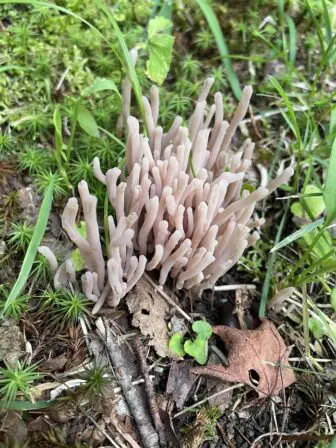Things I’ve noticed that are fun to share:
River birch in groups of three
I like this effect. The grouping makes an impact with the hues of shedding bark creating texture in all seasons. The branches hang gracefully, which is especially noticeable in birch that are 15 feet to 20 feet tall. These trees thrive in wetter conditions but I see them in areas where this wouldn’t be the case. As is usually true, when a species is planted on the edge of its optimal conditions, in wetter soil it can thrive with full sun and in medium soil it can use a bit of shade throughout the day for balance.
Bottlebrush buckeye
On a recent plant-shopping excursion, I noticed a wall of shrubs growing in a shady area with spires of tiny white flowers covering it. It was a “where have you been all my life?” moment. Even though I’m certain the deer will love it to death, I am committed to finding a way to bring this woody plant into my landscape.
Bottlebrush buckeye (Aesculus parviflora) likes to grow on the edge of the woods in part-to-full shade and will form a thicket. That’s not a consideration for tidy foundation planting but certainly one that will enjoy taking up space in a larger area. Although it is found more often in the Southeast, it is hardy in Zone 5 and would manage here, as it was thriving in the Catskills, where I saw it.

All of the fungi
I could take photos of mushrooms all day, given the recent swampy humidity and downpours. There are more shapes, sizes and colors than I’ve seen. All of these spores have been here waiting for the right conditions to sprout and delight me with their funky selves.
Mushrooms require careful observation or they can be missed. A cluster of slender, white shoots I found and was hoping might be ghost pipe (Montropa uniflora), a rare herbaceous plant that doesn’t have chlorophyll, was helpfully identified on social media as smoky coral fungus instead.
It resembles a sea urchin with wavy shoots coming up among the moss. Important: I am not a forager and am not consuming mushrooms I find in the yard and the woods, even if I think I can identity them.
Snakes
OK, not a plant, but it’s apparently been a good year for snake populations, based on the daily sightings in my yard. I live in good habitat. There are a lot of rock walls, brush piles and wood stacks that house mice and other prey. There are tall grasses and a pond and stream that are good habitat for frogs. Sorry, no chicken eggs this year. A black rat snake favors our coop, but sadly the hens are past their laying years. Or are they?
Bring on the pollinators
July is the peak of buzzing and fluttering in my yard and all the activity brings me joy. If you garden for ecological reasons, the reward is getting to have up-close experiences with the diversity of insects that will appreciate the efforts.
Speaking of pollinators
Every year groups of dedicated gardeners are filling public spaces with expanding native plant gardens. Check out the Philipstown Town Hall landscaping, the Desmond-Fish Public Library meadow, the Butterfield Library gardens or the pocket meadows popping up around Beacon, to name a few. I’ll write more about these efforts in a future column.
Rain barrels or swales?
After last year’s extended drought and the very dry spring in the Highlands, gardeners were installing rain catchment systems and seeking out hardy plants that could thrive with less water. After our recent bouts of extreme precipitation — are we really at 14 inches of rain so far this July? — now we’re thinking about how to direct the water, create places for it to soak in and protect plantings (and structures) from too much rain.
Models for New York in a warmer climate have predicted these scenarios and we are now in, as the saying goes, “the new normal.” For gardeners, climate resilience means we need it all in our landscapes. Go ahead and install the rain barrels, plant a rain garden or three, build a swale. We need to be creative and strategic about how to grow and conserve landscapes that flow with this essential resource and acknowledge its power.


Glad to hear you are going to write about the pollinator gardens. Don’t forget the original one in Nelsonville at the trailhead and the two in WPFP. The pollinators are fortunate to have dedicated people planting, watering and weeding. They do not just happen!
Bottlebrush buckeye is my favorite shrub and we have a few on our property. I always wondered why people do not plant it more often. It grows well here in Philipstown — I’ve spotted a few around Lane Gate Road and while heading toward Beacon that are quite spectacular. It’s deer resistant but butterflies and other pollinators love it.